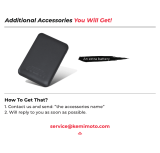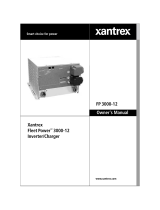Page is loading ...

A D V A N C E D A V I O N I C S , I N C .
HyperBlast Battery Charger
Users Guide
2006-2008 Advanced Avionics, Inc. All Rights Reserved
6118 Gotfredson Rd.. • Plymouth, MI 48170
Phone 734.332.0256 • Fax 734.418-2017
Updated December 18, 2008

Warranty and Warnings
he standard LaserBlast warranty includes all parts and labor for a period of
one year from the date of delivery. Shipment to Advanced Avionics, Inc. is
the responsibility of the customer. Advanced Avionics will pay for return
shipment in the same manner as the item was shipped to Advanced Avionics.
Damage due to excessive abuse is not covered. Examples of such abuse include but
are not limited to:
• Battery cables being ripped apart due to not pushing on the release knob on
the battery cable on the back of the vest and on the chargers.
• Batteries being dropped on floor
• Batteries being carried by the connector or wires and not by the body of the
battery.
Battery Safety
Please read and follow the following handling instructions. Improper use of the
batteries may cause heat, fire, explosion, damage, or capacity deterioration of the
battery.
DANGER
1.
Do not let leaked electrolyte come into contact with the eyes or
skin.
In such a case, immediately wash the area of contact with
clean water and seek help from a doctor. If not treated quickly,
prolonged contact may cause serious injury.
2.
Do not put the battery into a fire. Do not use it or leave it in a
place near fire, heaters, or high temperature sources.
In such a case, the insulator in the battery may be melted, the
safety vent and structure may be damaged, or the electrolyte
may catch fire, all of which may cause heat generation,
explosion, or fire.
3.
Do not use, charge, or leave the battery near fire or in a car
under the blazing sun.
Such a high temperature may cause damage of the protecting
device in the battery, which may result in an abnormal
chemical reaction, and then heat generation, explosion, or fire.
4.
Do not charge the batteries with any charger other than the
T

Advanced Avionics, Inc. LaserBlast charger. Use of any other
charger may cause heat generation, explosion, or fire.
5.
Do not throw or drop the battery.
Strong impact may damage the protecting device, which may
cause an abnormal chemical reaction and result in heat
generation, explosion, or fire.
6.
Do not disassemble or alter the battery.
The battery employs a safety mechanism and a protecting
device in order to avoid any danger. If these are damaged,
heat, explosion or fire may be caused.
WARNING
1.
Do not use the battery in other than the following conditions;
otherwise, the battery might cause heat generation, damage,
or deterioration of its performance.
Operating environment;
When the battery is charged: 0ºC +40ºC (32°F - 102°F)
When the battery is discharged: -10ºC +60ºC (14°F- 40°F)
When stored less than a month: -20ºC +50ºC (-4°F - 122°F)
When charged 50%
When stored more than a month: -20ºC — +35ºC (-4°F - 95°F)
When charged 50%
NOTICE
1.
Read the instructions of your equipment regarding the battery
installation and removal from the equipment so as not to
mishandle and waste the battery.
2.
Despite being rechargeable, t
he battery has a limited life span.
Replace when usage time between charges becomes short.

3.
Nicad, NiMH and Li-Ion batteries should be recycled. Be
environmentally conscious - do NOT throw these batteries in
the trash.
If you don't know where your local recycling facility is, call the
Portable Rechargeable Battery Association at 1-800-822-
8837.
They will provide you with the address of the recycling center
nearest to you
Battery Charger Safety
Safe operation of the battery charger requires following these instructions:
• Do not put anything on top of a battery charger.
• Allow a 2” space at the rear of the charger for airflow to release heat..
• Only connect Advanced Avionics Inc. Laser Blast batteries – NEVER
anything else.
• Always push release button to remove batteries from charger.
• If charger or battery wires are damaged or frayed, discontinue use immediately
and call Advanced Avionics for service.

Basic Use of the Charger
The LaserBlast HyperBlast Charger has several safeguards to prevent overcharging and
maximize the life of your batteries.
On batteries with 3 leads, the charger will monitor the temperature of the battery
and shut down over 50 deg. C.
The charger tests itself (POWER ON SELF TEST, or POST) every time it is
turned on. If the LED does not light for 2 seconds when the charger is first turned on,
that channel of the charger is not functioning correctly.
After 8 hours on a trickle charge, the charger will set the charge current to 0.
The charger will not allow more than 150% of the capacity of the battery to be
applied to the battery during rapid charge.
The charger will shut down if it cannot reach a minimum voltage after detecting a
battery has been plugged in. It will blink at 5 per second in this case.
The charger circuit board contains a temperature sensor that monitors the charger
temperature and will shut down if it exceeds 70 deg. C.
The charger will not restart the rapid charge sequence if the battery is already more
than 75% full. It will finish the charge in trickle charge mode.
If you unplug a battery and plug it back in, then the charger will restart its charging
sequence, including a minimum 10 minute rapid charge. This could potentially
overcharge a battery and should be avoided.
The power supply in the battery charger has thermal and overvoltage protection. If
it sees an overload, it will turn itself off automatically. To reset it, you must turn the
charger off for at least 5 seconds and then turn it back on.

The HyperBlast charger can be used in either 110 volt 60 hz countries, or in 220
Volt 50 Hz countries. It is very important to set the 110/220 switch on the rear of the
unit to the correct voltage. Failure to set this correctly will destroy the charger. If your
charger does not have this 110/220 switch, then it will autodetect the correct voltage.
Status LED Battery Status
On Solid Battery is Rapid Charging
Slow Blink – Once per second Battery has peaked and is now trickle
charging at 3% of capacity
Fast Blink – 5 times per second Battery Charger has shut off because one
of the following:
a) The battery is full
b) The battery is > 50 Deg C
c) The charge time has expired
All LEDs blinking rapidly in sequence The Charger has detected an internal
charger temperature greater than 70 Deg
C. and has shut down all outputs. You
must turn the power off and back on in
order to reset the charger.
110/220
Voltage

Do I have to dishcarge my
batteries?
Both NiCd and NiMH batteries have a limited number of times you can charge and
discharge them. The best way to get the absolute best life out of your battery is to only
use it in a vest when you need it. Discharging batteries before charging only uses up
more of the life of the battery. Having said that, there are conditions in a battery that
can cause the run time of a vest to become annoyingly low (<6 hours). If this
happens, make sure that the battery has been discharged long enough so that the low
battery indicator is lit on the shoulders, and then fully charge the battery.
Do not leave the battery connected in a vest to discharge the battery overnight. This
could potentially cause individual cell voltage reversal and damage the battery. The
shoulder low battery indicators are the right indicator that the if a battery has been
charged at a high temperature, oonThe LaserBlast HyperBlast Charger was designed to
allow the end user to replace the pigtail cables if the Hypertronics connector is broken.
Repair of the Charger
The LaserBlast HyperBlast Charger was designed to allow the end user to replace the
pigtail cables if the Hypertronics connector is broken. All other repairs should be
referred to a qualified service technician.
To replace a pigtail, simply loosen the screws holding the strain relief bar, remove the
bad pigtail, and click a new one on. Replace the strain relief bar to prevent damage to
the white molex connectors.
/





